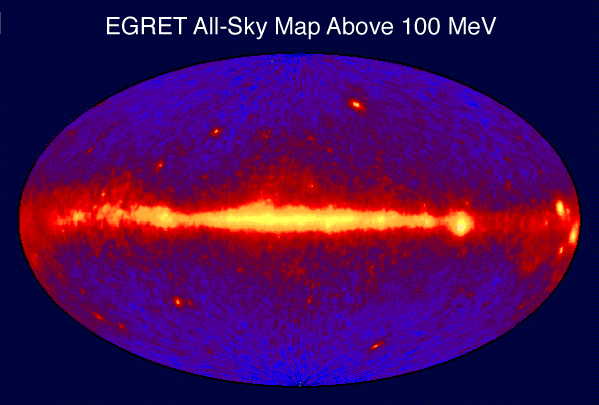Gamma Rays
Gamma radiation, also known as gamma rays or hyphenated as gamma-rays and denoted as γ, is electromagnetic radiation of high frequency and therefore high energy. Gamma rays typically have frequencies above 10 exahertz (or >1019 Hz), and therefore have energies above 100 keV and wavelengths less than 10 picometers (less than the diameter of an atom). However, this is not a hard and fast definition, but rather only a rule-of-thumb description for natural processes. Gamma rays from radioactive decay are defined as gamma rays no matter what their energy, so that there is no lower limit to gamma energy derived from radioactive decay. Gamma decay commonly produces energies of a few hundred keV, and almost always less than 10 MeV.

Gamma Decay
Illustration of an emission of a gamma ray (γ) from an atomic nucleus
Gamma rays are ionizing radiation and are thus biologically hazardous. They are classically produced by the decay from high energy states of atomic nuclei, a process called gamma decay, but are also created by other processes. Paul Villard, a French chemist and physicist, discovered gamma radiation in 1900, while studying radiation emitted from radium during its gamma decay. Villard's radiation was named "gamma rays" by Ernest Rutherford in 1903.
Gamma Ray Sources
Natural sources of gamma rays on Earth include gamma decay from naturally occurring radioisotopes such as potassium-40, and also as a secondary radiation from various atmospheric interactions with cosmic ray particles. Some rare terrestrial natural sources that produce gamma rays that are not of a nuclear origin, are lightning strikes and terrestrial gamma-ray flashes, which produce high energy emissions from natural high-energy voltages. Gamma rays are produced by a number of astronomical processes in which very high-energy electrons are produced. Such electrons produce secondary gamma rays by the mechanisms of bremsstrahlung, inverse Compton scattering and synchrotron radiation. A large fraction of such astronomical gamma rays are screened by Earth's atmosphere and must be detected by spacecraft. Notable artificial sources of gamma rays include fission such as occurs in nuclear reactors, and high energy physics experiments, such as neutral pion decay and nuclear fusion.
Gamma Rays vs. X-Rays
Gamma rays have characteristics identical to X-rays of the same frequency—they differ only in source. At higher frequencies, γ rays are more penetrating and more damaging to living tissue. They have many of the same uses as X-rays, including cancer therapy. Gamma radiation from radioactive materials is used in nuclear medicine.
The distinction between X-rays and gamma rays has changed in recent decades. Originally, the electromagnetic radiation emitted by X-ray tubes almost invariably had a longer wavelength than the radiation (gamma rays) emitted by radioactive nuclei. Older literature distinguished between X- and gamma radiation on the basis of wavelength, with radiation shorter than some arbitrary wavelength, such as 10−11 m, defined as gamma rays. However, with artificial sources now able to duplicate any electromagnetic radiation that originates in the nucleus, as well as far higher energies, the wavelengths characteristic of radioactive gamma ray sources vs. other types, now completely overlap. Thus, gamma rays are now usually distinguished by their origin: X-rays are emitted by definition by electrons outside the nucleus, while gamma rays are emitted by the nucleus.
Exceptions to this convention occur in astronomy, where gamma decay is seen in the afterglow of certain supernovas, but other high energy processes known to involve other than radioactive decay are still classed as sources of gamma radiation. A notable example is extremely powerful bursts of high-energy radiation normally referred to as long duration gamma-ray bursts, which produce gamma rays by a mechanism not compatible with radioactive decay. These bursts of gamma rays, thought to be due to the collapse of stars called hypernovas, are the most powerful events so far discovered in the cosmos. Astrophysical processes are the only sources for very high energy gamma rays (~100 MeV).

Gamma Ray Sky Map
This is an image of the entire sky in 100 MeV or greater gamma rays as seen by the EGRET instrument aboard the CGRO spacecraft. Bright spots within the galactic plane are pulsars (spinning neutron stars with strong magnetic fields), while those above and below the plane are thought to be quasars (galaxies with supermassive black holes actively accreting matter).
Health Effects
All ionizing radiation causes similar damage at a cellular level, but because rays of alpha particles and beta particles are relatively non-penetrating, external exposure to them causes only localized damage (e.g., radiation burns to the skin). Gamma rays and neutrons are more penetrating, causing diffuse damage throughout the body (e.g., radiation sickness, cell's DNA damage, cell death due to damaged DNA, increasing incidence of cancer) rather than burns. External radiation exposure should also be distinguished from internal exposure, due to ingested or inhaled radioactive substances, which, depending on the substance's chemical nature, can produce both diffuse and localized internal damage. The most biological damaging forms of gamma radiation occur at energies between 3 and 10 MeV.